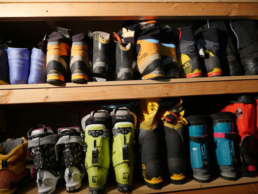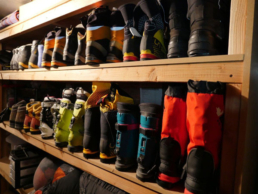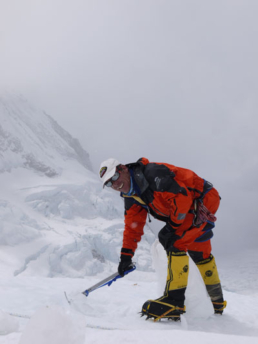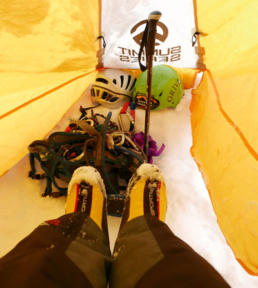Boots for the mountains
A data dump about being well shod.
A review by Guy Cotter, CEO of Adventure Consultants.
If you took a look into my gear storage area you’d see that I have accumulated such an array of alpine footwear that I could be accused of suffering the same disorder as Imelda Marcos. She was famous for responding to accusations of having three thousand pairs of shoes with the retort `I don’t have three thousand pairs of shoes, I only have one thousand and sixty!’
No doubt Imelda could justify her trove of shoes as being an absolute necessity for the First Lady of the Philippines, just as I justify my own collection of alpine footwear. But in all seriousness, I can justify my boot fetish because the one item of gear that connects us to the terrain is our boots, and as there just isn’t one set of boots that you can use for every occasion, we, therefore need lots of them! (I’ve clearly convinced myself of that if you hadn’t noticed) My own quiver includes trekking boots, base camp boots, extreme cold weather polar boots, light alpine boots, bivvy boots, boots for ascents up to 6000m, and boots specific for 8000m peaks.
Then I have a bin full of rock shoes, I have ski boots, and ski touring boots. When I think about it the list goes on and on if I include bike shoes (road and MTB), running shoes, approach shoes, work shoes, then yep, me and Imelda do have a lot in common (only the shoe part, not the corrupt use of government money). One distinction may be that due to sanitation requirements, my collection that ranges from the not yet old enough to stink variety – through to verging on fetid, and the latter may fail to pass the inspection procedure for inclusion into the Marikina Shoe Museum display like Imelda’s did (I’m serious, there is actually a Shoe Museum out there).
So what, your significant other might ask, do we need all these boots for? Well, the short answer is that the correct boot for the specific activity is paramount to enjoyment and safety (the safety card is a good one to pull when your expensive boot collection is taking up half your storage space and you can’t afford to upgrade the car). But there is no one boot that does it all and if you are someone who partakes in multiple mountain disciplines and the manufacturers are producing discipline-specific footwear then it makes complete sense to get the right footwear for each of your obsessions, right? Or perhaps you are still evolving and only partake in one mountain activity and then the job of selection is somewhat easier.
Before you rush off and drop the equivalent filthy lucre on a pair of new boots that would support a family in Somalia for 6 months, there are some important considerations to take into account. One of the big issues with footwear is that you usually can’t trial it in battle conditions before you hand over the coin and it’s not uncommon for people to get out on the side of the hill and after three hours suffer horrendous blisters that with determination and perseverance will lead to irreparable bone spurs. With that in mind it is worth noting that each manufacturer builds their footwear around a specific `last’, or a model of their textbook `vision’ of the perfect foot that usually mimics a dweeby narrow profiled Italian foot with the perfect arch, small heels and narrow forefoot. That description is the antithesis of my foot shape and is the very reason behind my subsequent obsession with boots and chasing the perfect fit. The trick is to find a manufacturer whose `last’ mimics your own foot shape but that hallelujah moment only comes about as a result of trial and error and if you have feet like mine, there may also be a considerable expense on that journey. If you are able to hire a boot that works for you before you buy then you could end up saving a lot of dosh and avoid torturing your feet unnecessarily. The good news is that once you do lock in on a specific brand that suits your foot shape you’ll probably end up with numerous models from that same manufacturer.
There was a time when insulation was delivered by the number of socks you wore inside a boot but with the array of boots on the market now that are built specifically for the terrain you intend to conquer, and with them having the appropriate amount of insulation for the conditions you will encounter, there is no need for any more than one pair of socks. Indeed wearing two pairs of socks generally leads to sock bunching inside the boot, foot pain, and almost certain blisters. Just to make matters worse, the second pair of socks will make your foot colder rather than warmer because they will constrict the circulation and cut off blood flow. Unless of course, your boots are way too big in the first place and you need the second sock to fill it out, in which case you should have got the correct size when you bought them. I’m so fussy that I will only wear a sock of a specific thickness in a specific boot (I bet I do have more socks than Imelda). This is because the fit I achieve can only be managed by having precisely the right sock for that boot; a thicker sock will cramp up my foot and a lighter one will make it sloppy.
I will fit my boots tighter in a technical boot (with a thinner sock) and less so for a cold weather high altitude boot (you got it, with a thicker sock). But when I say tighter in the technical boot I don’t mean that they are tight, they are snug and that’s it. There is room to wiggle my toes (just) and I don’t want to have any pressure points on my heels or the sides of my feet. If your toes are bunched up at the end of the boot you’ll grind your digits into a fleshy pulp on a long downhill then relegate those boots to the storage shed along with all the others that didn’t fit for one reason or another.
In modern leather boots, there will be a little stretching or bedding in of the insulation, so they should get a little more comfortable after a few days use. I’ll carry tape with me on my first few forays with a new pair of boots and as soon as I feel any pressure points I will apply tape before a blister forms. I `pre-tape’ my known pressure points before I even squeeze into some of my tighter boots as I know where the rubbing will occur and I’m better off avoiding it than trying to fix it after the fact.
In high altitude boots, I’m after more room so there are fewer pressure points to worry about and my feet can swell a bit with no decrease in comfort. As an example of the size range of my feet; the technical boot I use for ice climbing and alpine climbing is quite tight and may give me a little grief after a long walk downhill yet give me no blisters is a size 43.5. My 6000m alpine boots are size 44 and comfortable with a medium thickness sock while my high altitude boots are a roomy size 45.5.
Boot fitters will often encourage their victims to purchase expensive foot beds that will `support the foot and avoid foot damage’ caused by endless treks on moraine with heavy packs. But my experience has been that because I have a high volume foot that the foot bed takes up valuable space inside the boot that throws off the ability of the boot to fit around my foot properly. My own experimentation has proved to me that I’m better with a very low volume insole instead. Conversely, people with a low volume foot will appreciate the ability of the foot bed to fill excess space should that be required.
No one wants to get cold feet out there and I’m no exception. While I’ve had very cold toes at times I’ve dealt with it over the years by wiggling my toes back into life and I’ve therefore not succumbed to frostbite. There have been times where I’ve had to stop and rewarm my feet but this is a very hard thing to do on a cold snowy mountainside because the inside of the boots will freeze when you take them off so you have to be very selective on where and how you do this. Most modern altitude boots are well insulated and most people with moderately good circulation will be just fine if they adhere to some basic principles for self-care. That involves having dry socks and inner boots. You must ensure you have dry liners before summit day and that can only be achieved if you either dry your liners the night prior to departing for the top or not get them moist in the first place. Once they are damp, drying boot liners isn’t just a result of the process of stowing them in your sleeping bag, the liners have to be turned inside out for any heat to get to them. A good option is to wear a vapour barrier the day prior to avoid any moisture getting into the liner. This may be as simple as wearing a plastic bag over your socks or using one of the commercial vapour barrier systems. Be careful though, as a thicker vapour barrier such as some of the neoprene ones may be thicker than your normal socks and compress your feet.
Any number of people have come off a successful summit of an 8000m peak but then crashed out to sleep exhausted in their tent that night without taking their boots off. Then, when they get back down to Camp 2 the next day discover their toes are all black. This indicates a myriad of issues with these people that I won’t go into except to say it is generally indicative of people who aren’t that aware of their body and who don’t value their feet that much and are often way out of their depth (but generally don’t realise it). Meanwhile, in the tent next door, there will be a group of people who summited the same day in the same conditions and not a skerrick of damage to be found. It’s not a mystery.
For those who are circulatorily compromised (if The Donald can make up words so can I), boot heaters are the godsend that enables these people to get by in the extreme cold. There are several models available online that consist of a heating element you stick to your insole that is connected via a cable to a battery pack that you clip to your boot. These deliver a constant low heat for as long as 12 hours and eliminate the chance of frostbite if you’re in a good boot that you’ve kept dry. The issues with them are that most of the battery packs are quite heavy, so much so, that if you are still someone who carries your own gear you may decide that extra 400gms just isn’t worth it. Another issue is that most of these batteries require a wall plug to charge them and there just aren’t that many of those in the high mountains and you have to rely on them holding a charge for a long time before you use them.
I did just see a pair of heated socks that looked like they will be the ducks nuts and lighter than the battery packs on the foot beds so technology is moving forward to make us more comfortable but it is worth sticking to the basics of dry liners and fresh socks before a hard and cold summit push.
2 Comments
Add comment Cancel reply
This site uses Akismet to reduce spam. Learn how your comment data is processed.








Holy crap, that boot storage room is bigger than my flat during university times used to be :D. I don’t really get tho why your high altitude boots is 1.5 sizes larger than your 6000m alpine boots tho. I wore my “up to 6000m boots” on different occasions in Nepal and Russia and they are exactly the same size (and brand) as my usual trekking boots for daytrips in the alps e.g. – Never had any problems with them even on the way down.
I tried on 8000m boots: 1.5 sizes larger than my regular size and i was just swimming around in them since they are massive already (of course while wearing thick socks+liners). There is still some space in them while trying on my regular size.
Everyone’s got different feet of course, but i don’t think sizing up this much makes sense for everyone or do you have a reason i should size up?
Yes that’s true, everyone should size according to what is comfortable for you. Something to keep in mind is that your feet can swell at altitude so it helps to avoid issues with constricting circulation and the potential for frostbite by allowing more room in your boots.